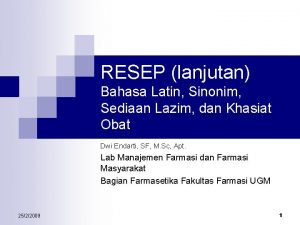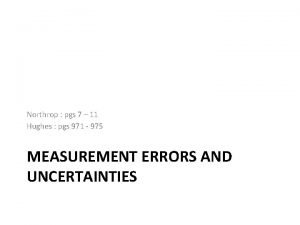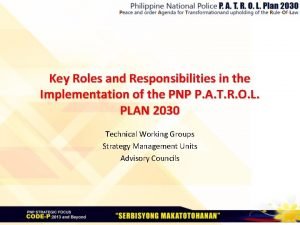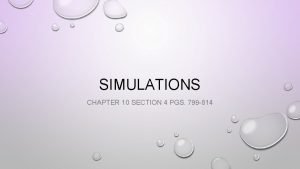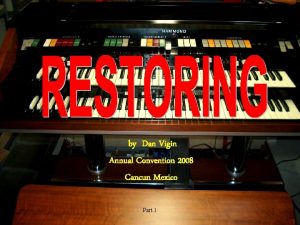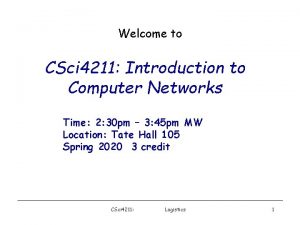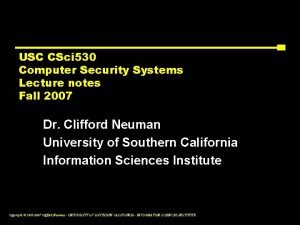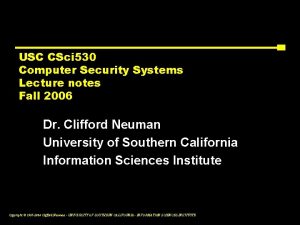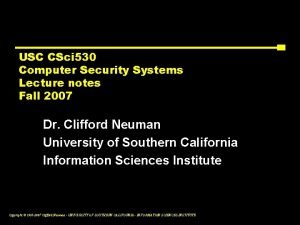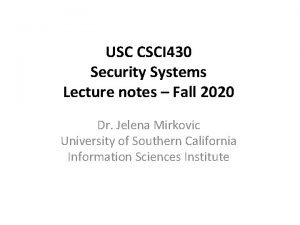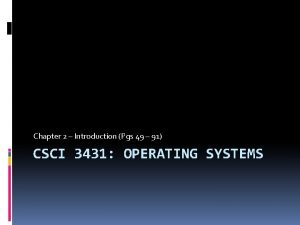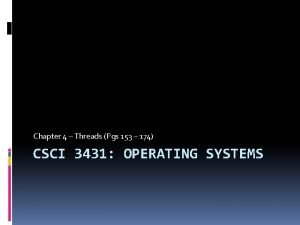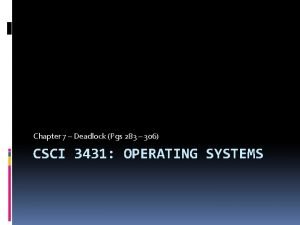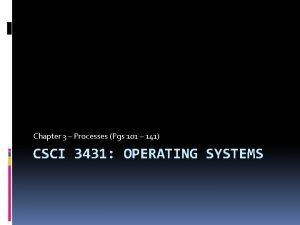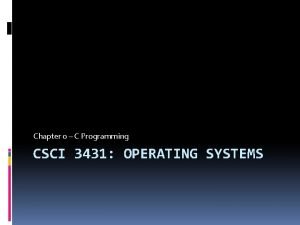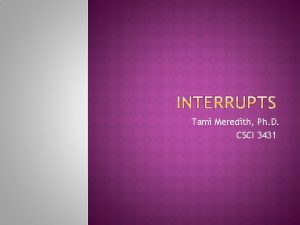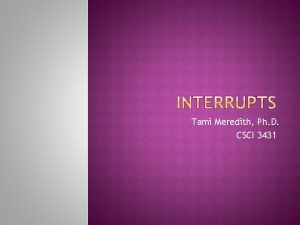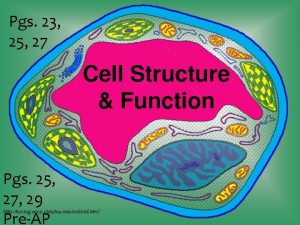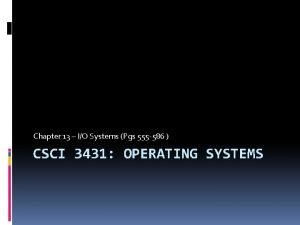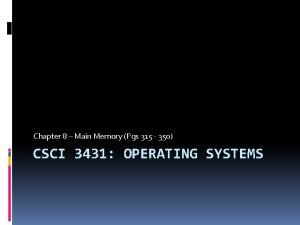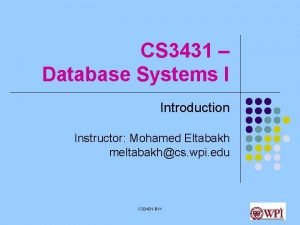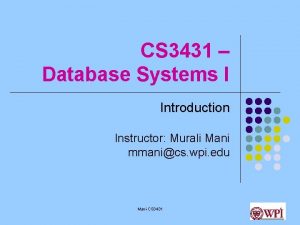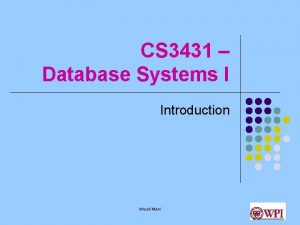Chapter 1 Introduction Pgs 3 42 CSCI 3431




















- Slides: 20

Chapter 1 – Introduction (Pgs 3 – 42) CSCI 3431: OPERATING SYSTEMS

Architecture Review SGG see a computer system as: 1. Hardware : CPU, Memory, I/O, communication 2. *Operating System* - The rest of the course 3. Applications: Programs that do stuff (and which may be layered, connected) -- Middleware: Connects multiple apps to users 4. Users: All users are not equal O/S is software that sits between the applications and the hardware.

(Another) Simplistic Layered View of Computing

The Factors Usability – Easy and intuitive to use, e. g. , Android , i. OS Efficiency – Fair and “optimal” use of resources (i. e. , hardware), e. g. , IBM z/OS Reliability – Uptime, MTF (real-time O/S), e. g. , QNX, Vx. Works (Mars landers, Phoenix, Airbus A 400, Boeing 787, Motorola modems) Security – e. g. , NSA Sectera Edge w. Win CE Size – for embedded O/S

Views Users Varying levels of ability/experience “User” Interface (UI) Often view Windowing System as “The” UI System Programmers, Administrators API, Admin tools Performance Components

My Views PC = Personal Computer, it does NOT mean a computer that runs Microsoft Windows Kilo. Byte = 210 bits (1024) NOT 1000 bits WWW is a group of protocols and applications that USE the Internet, it is NOT the Internet (also FTP, e-mail, Skype) OOPL have inclusion (subtype) polymorphism, not parametric polymorphism or just “polymorphism”

Bootstrap Loader When it is started, a CPU needs to start somewhere (e. g. , thread 0 in core 0 in processor 0 starts up fetching code from address 0 xfffffff 0) At that address is the Bootstrap Loader Stored in non-volatile memory so its always there Setup registers (stack, PC, etc. ) Find and load the O/S Often just loads an O/S loader/init (e. g. , lilo, grub)

Windows Boot address 0 xfffffff 0 resides in BIOS (non-volatile ROM) Initialise the system: CPU; RAM, Interrupt, DMA controllers; Basic hardware Run user interface if selected Attempt to load boot sector (drive A, platter 1, cylinder 1, sector 1) to ox 7 C 00 Boot sector contains Bootmgr. exe: Copies Winload. exe to RAM and transfers control to it Winload. exe: Prepares disk for general use, loads the kernel, sets up basic drivers (memory etc. ), and the transfer control to the kernel

Interrupt Event that triggers O/S operation E. g. , incoming packet on ethernet Requires hardware support in CPU Actual wires for hardware interrupts Special instruction for software interrupts Interrupt is usually used as an offset into an array of addresses – “Interrupt Vector” At each address is a routine that performs the task needed – “Interrupt Handler” Some interrupts can be “masked” (and then ignored)

System Call Operating systems are designed to support applications Can do common tasks such buffer and report key strokes Applications use these O/S facilities Accessing the O/S is done using System Calls Do setup then perform an interrupt to call Often hidden from programmers by compiler/library writers

Stuff you SHOULD KNOW (already) 1. 2. 2 Storage Structure (memory) 1. 2. 3 I/O Structure Will talk more about DMA later 1. 3 Computer Architecture Single vs. Multiprocessors, Multi-core Symmetric vs. Asymmetric Multiprocessing Non-Uniform Memory Access (and UMA)

O/S - Definitions “Program that manages the computer hardware. ” (pg 3) “Environment in which programs are executed. ” (pg 18) “An OS is software, consisting of programs and data, that runs on computers, manages computer hardware resources, and provides common services for execution of various application software. ” (wikipedia)

Events Most O/S are interrupt driven – they are reactive to interrupts A trap is an interrupt caused by an identifiable error, e. g. , writing to non-existent memory Not to be confused with untrappable CPU errors 0 x 0000 Divide by Zero Error 0 x 00000004 Overflow 0 x 00000005 Bounds Check Fault 0 x 00000006 Invalid Opcode (Instruction) 0 x 00000008 Double Fault

Operation Modes CPU support for an O/S – “mode bit” User (protected) Mode: CPU is executing user -level application Kernel (supervisor, system, privileged) Mode: CPU is executing O/S code Also, instructions exist to DISABLE interrupts (which is useful when processing an interrupt)

O/S Structure Jobs (or Tasks): Code + Data that needs executing Job Pool: All jobs awaiting execution Multitasking – executing more than one job at a time Pre-emptive multitasking (1 CPU) – do part of each job in sequence (same as time sharing) Time slice = amount of time given to a task before a context switch occurs

Computer Operation Interrupt Storm: When a CPU can’t execute user tasks because its busy executing interrupt handlers Context Switch: Changing the executing task Job Scheduling: Selecting the executing task (done by the O/S which is itself a task) PROCESS: A program (and its data) loaded into memory and executing (pg 20).

O/S in Action

O/S Responsibilities Process Management Scheduling – start, suspend, resume Creating, deleting Synchronising IPC – inter-process communication Memory Management Virtual memory, pages, swapping Fragmentation control Caches (level 3) Storage Management Files & Directories Free space, storage allocation, disk scheduling, search I/O Control - Printers, Scanners, Network connections User Administration and Security/Access Control

Operating Systems Distributed: Permit a user to use resources on multiple machines (e. g. , access files or run tasks on other computers) Embedded: Inside a device such as a cell phone, microwave, airplane Real-time: Performance subject to rigid time constraints (almost all embedded systems) Compact: Power, UI, & memory restrictions exist (e. g. , i. OS, Palm. OS, Android) Special Purpose: e. g. , Google O/S on search hardware

To Do: Read Chapter 1 (pgs 3 -42; this lecture): All material is very introductory and testable Read Chapter 2 (pgs 49 -91; next lecture): All material is testable


